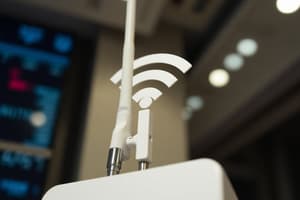Podcast
Questions and Answers
Wi-Fi stands for Wireless Fidelity.
Wi-Fi stands for Wireless Fidelity.
True (A)
Wi-Fi uses radio waves to connect devices wirelessly.
Wi-Fi uses radio waves to connect devices wirelessly.
True (A)
Bluetooth has higher data transfer rates compared to Wi-Fi.
Bluetooth has higher data transfer rates compared to Wi-Fi.
False (B)
The term Wi-Fi was coined in the early 1970s.
The term Wi-Fi was coined in the early 1970s.
Wi-Fi operates only in the 5 GHz frequency band.
Wi-Fi operates only in the 5 GHz frequency band.
Wi-Fi has become ubiquitous and can be found in airports, coffee shops, and hospitals.
Wi-Fi has become ubiquitous and can be found in airports, coffee shops, and hospitals.
Wi-Fi routers automatically select channels based on color strength and height requirements.
Wi-Fi routers automatically select channels based on color strength and height requirements.
When connected to a Wi-Fi network, physical cables are required to transmit information between devices.
When connected to a Wi-Fi network, physical cables are required to transmit information between devices.
Public Wi-Fi networks usually do not require any authentication for users to access them.
Public Wi-Fi networks usually do not require any authentication for users to access them.
One advantage of using Wi-Fi is the elimination of cable clutter due to wireless communication.
One advantage of using Wi-Fi is the elimination of cable clutter due to wireless communication.
Wi-Fi allows devices to move freely within coverage areas without losing connection, unlike wired LAN systems.
Wi-Fi allows devices to move freely within coverage areas without losing connection, unlike wired LAN systems.
One disadvantage of Wi-Fi technology is the lack of security concerns due to advanced encryption standards.
One disadvantage of Wi-Fi technology is the lack of security concerns due to advanced encryption standards.
Flashcards are hidden until you start studying
Study Notes
What is Wi-Fi?
Wireless Fidelity, commonly known by its acronym Wi-Fi, is a technology designed to connect devices wirelessly using radio waves. It's a standardized communication protocol used in local area networks (LAN) over short distances to enable higher data transfer rates between devices compared to other wireless technologies like Bluetooth. This makes it suitable for home networking environments where multiple users need access to high bandwidth applications such as video streaming, online gaming, and file sharing.
Background of Wi-Fi Technology
The development of Wi-Fi started with early research conducted on packet radio systems during the late 1970s, which was later called Ethernet when implemented through wires. However, the term Wi-Fi wasn't coined until 1998, and it gained popularity in the mid-to-late '90s due to improvements in security features from Wired Equivalent Privacy (WEP), which made it more secure and easier for consumers to set up their own personal hotspots. Today, Wi-Fi has become ubiquitous; it's found everywhere from our homes to airports, coffee shops, schools, and hospitals, making internet access available almost anywhere we go.
How Does Wi-Fi Work?
Wi-Fi operates within certain frequency bands, the most common being 2.4 GHz and 5 GHz, allowing devices to communicate via radio signals. When you turn on your phone or laptop near a router, your device will scan for available Wi-Fi channels and automatically select one based on signal strength and speed requirements. Once connected, your computer can transmit information back and forth across the network without needing physical cables connecting all machines together—a significant improvement over traditional Ethernet connections.
In order to maintain privacy while using public Wi-Fi, many routers require authentication before granting access. For instance, if you visit Starbucks, they may have a password-protected SSID (Service Set Identifier) that customers must enter into their phones or laptops before they can get online. This ensures only authorized users can gain entry to your private network space.
Advantages of Using Wi-Fi
Some key benefits of using Wi-Fi include:
-
Convenience: With Wi-Fi, there’s no need for unsightly cable cluttering around your living room or office space. Instead of plugging each device directly into the modem with an ethernet cord, everything communicates wirelessly.
-
Mobility: Unlike wired LAN systems where computers and printers must remain tethered close to the central hub, with Wi-Fi, users can move about freely throughout coverage areas without losing connection.
Disadvantages of Using Wi-Fi
Despite these advantages, some challenges exist with Wi-Fi technology:
-
Security concerns: While improved encryption standards help prevent unauthorized access, malicious actors could still potentially intercept sensitive data transmitted over open Wi-Fi networks.
-
Limited range: Although modern routers offer better coverage than older models, Wi-Fi signal strength diminishes rapidly beyond visual line-of-sight. This means that large buildings might require multiple repeaters or additional equipment to ensure reliable service throughout every corner.
Overall, Wi-Fi offers convenience and flexibility at home or workplaces, enabling us to stay connected even on the move. As technology advances, so too do enhancements in speed and reliability, ensuring this remains true well into the future.
Studying That Suits You
Use AI to generate personalized quizzes and flashcards to suit your learning preferences.




